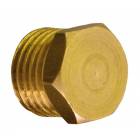Hydraulic fittings and their usage in various sectors of interest
Through the hydraulic fittings water flow is transported from one zone to another, thus reaching the required supply point

Gnali Bocia has been selling and producing hydraulic fittings for a long time. The technological processes used are different and turn rough brass into a fitting. The first operation the material is subjected to forging, a process which brings a metal up to high temperatures and deforms it plastically in such as way as to give the fitting geometrical characteristics that are close to the final ones it will have.
Gnali Bocia is equipped with a team of Transfert Machines and CNC Machines for finishing the hydraulic fittings after forging. A series of steps is then carried out to improve the surface finish of the component and other finishing processes such nickel-plating or chromium plating are performed. The assembly operations of the components that make up the hydraulic fittings are carried out by robotised systems in order to ensure utmost efficiency and uniformity to all the production batches.
During all this sequence, the mechanical properties and characteristics of hydraulic fittings undergo multiple changes in order to obtain specific physical values, such as resistance to yield stress and breaking.
To produce its hydraulic fittings Gnali Bocia uses brass, copper alloy (Cu) and Zinc (Zn) characterised by good malleability and resistance to corrosion. In comparison with copper, brass has higher hardness and that is another reason why it is considered a good alloy for the production of hydraulic fittings.
Gnali Bocia is equipped with a team of Transfert Machines and CNC Machines for finishing the hydraulic fittings after forging. A series of steps is then carried out to improve the surface finish of the component and other finishing processes such nickel-plating or chromium plating are performed. The assembly operations of the components that make up the hydraulic fittings are carried out by robotised systems in order to ensure utmost efficiency and uniformity to all the production batches.
During all this sequence, the mechanical properties and characteristics of hydraulic fittings undergo multiple changes in order to obtain specific physical values, such as resistance to yield stress and breaking.
To produce its hydraulic fittings Gnali Bocia uses brass, copper alloy (Cu) and Zinc (Zn) characterised by good malleability and resistance to corrosion. In comparison with copper, brass has higher hardness and that is another reason why it is considered a good alloy for the production of hydraulic fittings.
20/03/2013
I contenuti di questo sito non hanno carattere di periodicità e non rappresentano 'prodotto editoriale'.








